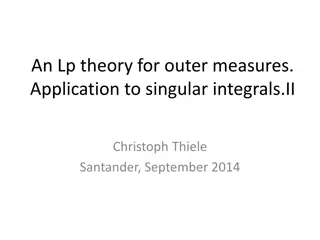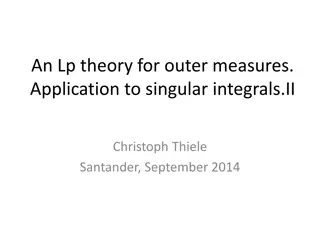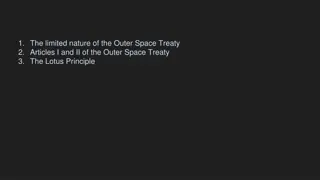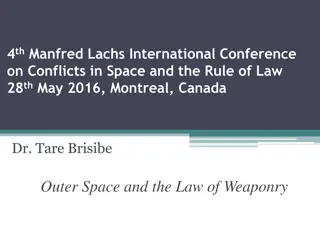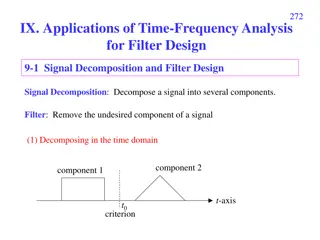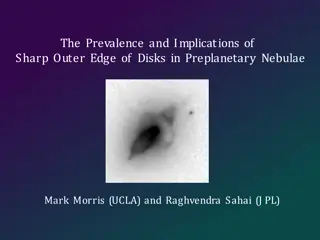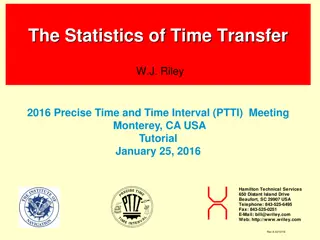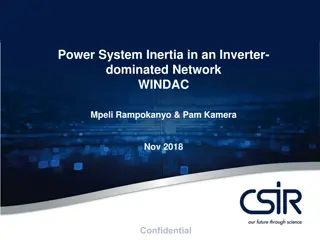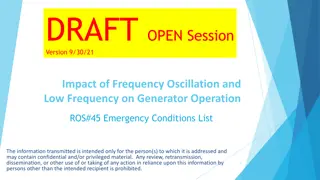Insights into Lp Theory for Outer Measures: Applications in Time-Frequency Analysis
Explore the application of Lp theory for outer measures in time-frequency analysis, focusing on generating sets, outer measures, average function sizes, essential supremum, Lp spaces, embedding theorems, paraproduct estimates, sparse operator estimates, bilinear Hilbert transform, degenerate cases, and boundedness of BHT.
Download Presentation

Please find below an Image/Link to download the presentation.
The content on the website is provided AS IS for your information and personal use only. It may not be sold, licensed, or shared on other websites without obtaining consent from the author. Download presentation by click this link. If you encounter any issues during the download, it is possible that the publisher has removed the file from their server.
E N D
Presentation Transcript
Lp theory for outer measures: Application to time-frequency analzysis Christoph Thiele Santander, September 2014
Recall Tents (or Carleson boxes) X is the open upper half plane, generating sets are tents T(x,s) : Define outer measure on X by
Sizes Sp average of function on a tent Also Sinfty
Outer essential supremum Space of functions with finite out.ess.supremum Outer essential supremum on a subset F:
Outer Lp spaces Define super level measures Define Lp norms Also weak Lp (Lorentz space)
Embedding theorems Thm: Define for fixed Schwartz function Then we have: If has integral zero:
Paraproduct estimates For two phi-I with mean 0 and one with mean 1 Hoelder with two qi equal 2 and one equal infty
Lerners sparse operator estimates For two phi-I with mean 1 and some G Hoelder with two qi equal infty and one equal 1
Bilinear Hilbert transform Consider vector Define the trilinear form The bilinear Hilbert transform is any of the pre-dual bilinear operators. May assume beta nonzero. By scaling may assume it is unit length. By change of variables may assume it is perpendicular to (1,1,1).
Degenerate case If two beta-I are equal, degenerate case. Reduce to pointwise product and Hilbert transf. We consider only one fixed non-degenerate case
Boundedness of BHT Theorem: Fix nondegenerate direction beta. Let Then there is an a priori estimate Extensions exist for p-I less than 2, but that is for some other time.
Symmetries Like CZ operators, BHT is invariant under simultaneous translation of f-i and has proper scaling under simultaneous dilation of f-i. It has additional one parameter modulation symm. This equals original BHT if alpha perpendicular to beta and (1,1,1). BHT shares symmetries with
New embedding map Additional symmetry makes the upper half plane embedding inappropriate and useless. Need embedding map reflecting the orbit of entire symmetry group : Phi assumed to have FT nonnegative and with small support near 0. The testing wavelets become arbitrarily high oscillating wavepacket.
BHT in terms of embedded fcts (Remark: The RHS is the bilinear Cauchy projection.) Two ways of proving this algebraic identity: 1) Exercise in applying Plancherel, akin to the proof of the Calderon reproducing formula. 2) Checking RHS satisfies the symmetries, and noting that any form with these symmetries is a linear combination as on LHS. Prove RHS not multiple of Lambda tilde to show a not 0.
Proof of symmetries By change of variables. Translation symmetry: y to y+y Modulation symmetry: eta to eta+eta Dilation symmetry: t to ts, y to ys, eta to eta/s
Not multiple of Lambda tilde For fixed eta,y,t we have a pairing of with a certain nonnegative bump. This bump is supported on the half space If is supported outside this half space, then form vanishes. If supported and positive in half space, then form does not vanish. So form not invariant under beta-modulation.
Outer Hoelder inequality Where we need to identify appropriate sizes S1,S2,S3 which satisfy size-Hoelder
Idea of sizes The j-size is a sum of L2 and Linfty average. The L2 is taken outside an exceptional region A-j. The three exceptional regions are disjoint.
Size-Hoelder To prove We split the integral over tent on LHS into four regions: three orange regions and the rest. On each exceptional region we do the appropriate 2-2-infty Hoelder, since we control two functions in L2. On the rest, either of the Hoelders is OK.
Modified outer measure space To formulate sizes precisely, express everything for F rather than G (change variables). Fix j. Tents: Size (pick small parameter b): Note: regions A Will be disjoint for different j after change vrbls.
Main embedding theorem After this preparation, bounds for BHT are reduced to embedding theorem For 2<p<infty
Few comments on the proof Story told by pictures


